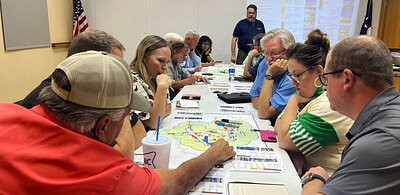
Texas Cities Plan for Boom: Dunaway Leads with Data-Driven Growth Strategies
As Texas surges ahead with unprecedented population growth, cities are turning to innovative planning solutions. Dunaway, a Texas-based firm, is helping communities navigate the challenges with comprehensive plans and cutting-edge GIS technology.
Texas Cities Plan for Boom: Dunaway Leads with Data-Driven Growth Strategies
AUSTIN, TX – November 17, 2025 – Texas is experiencing a population boom, and with it, a surge in demand for robust urban planning. As cities grapple with managing rapid growth while preserving community character, firms like Dunaway are stepping up to provide comprehensive solutions. The multidisciplinary planning, design, and engineering firm is working with municipalities across the state to navigate the complexities of expansion and ensure sustainable development.
Navigating the Texas Growth Surge
Texas has consistently ranked among the fastest-growing states in the nation, a trend projected to continue well into the future. Recent data confirms that the state surpassed 30 million residents in 2022 and is expected to reach over 32.4 million by 2030. This population surge presents significant challenges for cities, including strained infrastructure, increased traffic congestion, and the need for more housing, schools, and public services.
“The pace of growth is unprecedented, and it requires a proactive approach to planning,” said one city official involved in a Dunaway project. “We need to anticipate future needs and develop strategies to address them effectively.” This necessitates more than just reacting to growth; cities must actively shape their future with comprehensive plans and smart development policies.
Dunaway has been working with cities like New Fairview, Caddo Mills, Kennedale, and Bridgeport to create these plans, focusing on addressing those challenges with data-driven strategies. The firm’s integrated approach – combining planning, engineering, and GIS technology – allows it to offer comprehensive solutions tailored to each community's unique needs.
The Power of Data-Driven Planning
At the heart of Dunaway’s approach is the use of Geographic Information Systems (GIS) technology. The firm’s partnership with Esri, a global leader in GIS, allows it to leverage powerful tools for data visualization, analysis, and community engagement. “GIS is essential for understanding spatial relationships and making informed decisions about land use,” explained a GIS specialist working with the firm. “It allows us to see patterns and trends that would otherwise be hidden.”
For instance, in Caddo Mills, Dunaway used GIS to analyze the impact of growth along the I-30 corridor and identify areas suitable for parks and trails. The technology allowed the city to balance development with the preservation of natural resources and recreational spaces. In New Fairview, ArcGIS Online platforms are used for real-time collaboration and gathering community input on proposed projects. “Being able to visualize the future impact of a decision helps people understand the benefits and address concerns,” said a community leader involved in the planning process.
In Coryell County, Dunaway’s GIS solutions are reportedly helping the county to estimate repair costs, allocate budgets, and present accurate data to decision-makers, resulting in cost savings. This illustrates the potential for GIS to enhance efficiency and transparency in government operations.
Balancing Growth with Community Character
While economic development is important, cities are also concerned about preserving their unique character and quality of life. “Growth shouldn’t come at the expense of what makes our community special,” said a Kennedale resident involved in the city’s comprehensive plan update. “We want to maintain our small-town feel while still accommodating new residents and businesses.”
Dunaway emphasizes community engagement as a key component of its planning process. The firm works closely with city officials, residents, and stakeholders to gather input and ensure that plans reflect local values and priorities. In Kennedale, this involved extensive public meetings and online surveys to solicit feedback on proposed zoning changes.
However, it’s not always a smooth process. Proposed changes to the city’s Unified Development Code (UDC) have sparked debate among local business owners, who fear that the changes could negatively impact their operations. The Kennedale Alliance of Business Owners (KABO) has voiced concerns about shifting industrial uses to commercial, arguing that it could harm the city’s tax base. These differing viewpoints highlight the challenges of balancing competing interests during the planning process. Despite such hurdles, Dunaway works to address concerns and build consensus through transparent communication and collaborative problem-solving.
Dunaway’s work in Bridgeport, which focuses on preserving historical assets and strengthening infrastructure, is another example of how the firm balances growth with community character. The firm’s comprehensive plan aims to create a vibrant downtown area while protecting the city’s historic landmarks.
“It’s about finding the right balance,” said an urban planner involved in the project. “We want to create a community that is both prosperous and livable.”
📝 This article is still being updated
Are you a relevant expert who could contribute your opinion or insights to this article? We'd love to hear from you. We will give you full credit for your contribution.
Contribute Your Expertise →